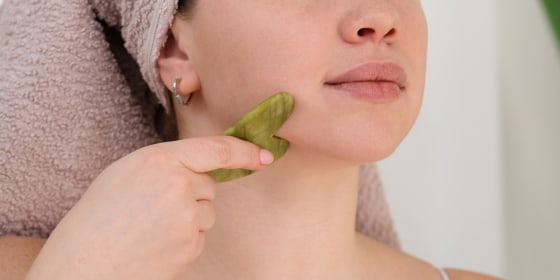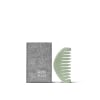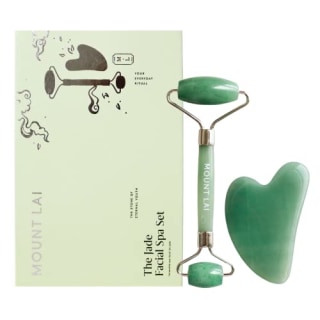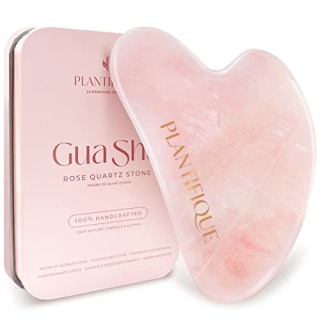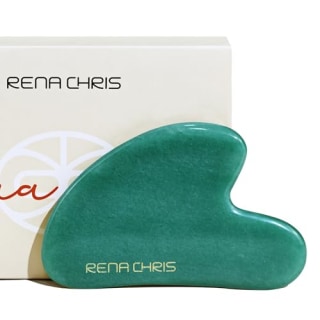One of my favorite things about getting a facial is that I always leave feeling more sculpted and chiseled — I love embracing the newfound definition of my cheekbones and jawline. After a day or two, however, that definition always reverts back, leaving me waiting until my next appointment for my face to look and feel that way again. One way I’ve learned to extend the life of my sculpted jaw post-facial is by doing the work myself (from the comfort of my bathroom) with easy-to-use skin care tools, like gua sha. Gua sha is a traditional Chinese practice that, with the help of a face, scalp or body oil, is designed to sculpt, tone and depuff the skin.
I spoke to massage therapists and Chinese medicine practitioners about the benefits and how to effectively use these tools on your face, body and scalp. I also compiled their recommendations and highly rated gua sha tools that are in line with expert guidance to shop.
SKIP AHEAD What is the gua sha? | What is the origin of gua sha? | How I picked the best gua sha tools | The best gua sha tools in 2024 | How to shop for gua sha tools | What are the benefits of gua sha? | How do you properly gua sha?
What is gua sha?
“Gua” means to scrape or scratch, while “sha” refers to reddish, elevated rashes that arise from the gua technique. It’s a traditional therapeutic technique that involves scraping the skin with a massage tool to improve circulation, relieve pain, balance the body’s Qi, relieve stagnation and help with lymphatic drainage and facial rejuvenation, says Safari.
What’s the origin of gua sha?
Gua sha is a traditional Chinese healing technique with the earliest records dating back to the Shang Dynasty, says Dr. Ming Zeng, a doctor of acupuncture and Chinese medicine. Historically, gua sha treated various ailments such as fever, muscle pain, inflammation, and even respiratory issues, according to Dr. Khatira Safari. It’s believed to balance the body’s energy (Qi) and restore health by clearing blockages along meridians (the channels through which Qi flows,) says Safari.
Gua sha was previously mostly used for improving blood flow to release Qi, but now researchers are exploring it having additional benefits such as stimulating the immune system, reducing inflammation, and relieving muscle tension, according to Safari.
How I picked the best gua sha tools
After speaking to experts, they suggest keeping the following when creating this list:
- Material: Gua sha tools are typically made of jade, rose quartz, bian stone, stainless steel and/or ceramic. Jade, which is the most traditional material, is known for its cooling properties and durability. Rose quartz is popular for its smooth texture and purported healing properties, while Bian stone is known for its mineral composition and therapeutic benefits. Stainless steel is a durable, hypoallergenic option that’s easy to clean, and ceramic is smooth and gentle on the skin, according to Dr. Irina Logman.
- Shape: Gua sha tools come in various shapes — each of which have different benefits. Heart-shaped tools are versatile and effective for facial contours, while wing-shaped options are great for large areas and deep muscle work. Smaller tools are best for detailed facial work and delicate areas, and comb-shaped tools are most effective for scalp massages.
- Price: Gua sha tools vary in price depending on their shape, design, stone and sourcing. This list has options as low as $7 and as high as $129.
The best gua sha tools in 2024
Best for face: Facegym Multi-sculpt
- Multiple edges in the design
- Easy to clean
- Can chill or heat it
- Higher price point
This stainless steel facial gua sha, which comes recommended by Zeng, has six edges — a long edge for lymphatic drainage, a grip edge for jawline sculpts and tension release, a medium edge to relieve pressure and sculpt the cheeks, a short edge for under eyes and brows, teeth for fine lines and a tip to work pressure points. The brand recommends using it with three to five drops of oil so it can glide over the skin without tugging. In between uses, you should clean and sterilize it to prevent spreading bacteria, according to Facegym.
Best for body: Wilding Aura Stone
- Multiple edges in the design
- Fragile stone
- Higher price point
This five-edged gua sha tool focuses on detoxifying, toning, sculpting and releasing tension. Reviewers say they love how large the tool is because you can cover a large surface area in one pass. Despite its large size, they also say it’s not too heavy or difficult to maneuver. Since bian stone is fragile, consider placing it in a pouch (sold separately) or on a protective cushion to avoid chipping or breaking, according to the brand. “I love using this when I need some depuffing, though I did drop it and the tip broke off,” says NBC Select editor Lindsay Schneider. “I have to be really careful with it.”
Best set: Mount Lai The Facial Spa Set
- Comes in different materials
- Nothing to note at this time
This set from Mount Lai includes a facial lifting tool and a depuffing facial roller, which work together to improve blood circulation, reduce puffiness and inflammation, relieve tension and encourage lymphatic drainage, according to the brand. It has a 4.6-star average rating from over 120 reviews on Amazon and you can choose from jade, rose quartz, amethyst and black obsidian for your stone choices.
Jade is best for balancing, rose quartz is best for soothing, amethyst is known for calming and black obsidian is warming, according to Mount Lai.
Best stainless steel gua sha: Sacheu Beauty Gua Sha
- Antibacterial
- Durable
- Suitable for all skin types
- Naturally has a cold feeling
This stainless steel option comes recommended by Zeng and is great for those who don’t want a porous stone material to gua sha their face. Using the traditionally shaped tool will help with lymphatic drainage, lift and firm the skin and relieve tension without building up bacteria, according to the brand. Reviewers say that they saw a noticeable difference in the appearance of their faces after only a few consistent uses. It has self-cooling properties so it has a natural cold feeling on the skin without needing to go in the fridge or freezer, according to the brand.
Best rose quartz gua sha: Plantifique Rose Quartz Gua Sha Tool
- Can use on face and body
- Available in many materials
- Comes with an e-book guide
- Nothing to note at this time
Reviewers say this gua sha tool, which has a 4.6-star average rating from over 14,600 reviews on Amazon, is easy to use because it fits comfortably in their hand and is effective at reducing inflammation and sculpting both their face and body. It also helps improve fine lines, relieve congestion and reduce muscle stiffness, according to the brand. The self-cooling stone comes in an aluminum case with cushioning to protect your fragile stone between uses; however, if it does break, your tool is under warranty as long as you register it.
Best for scalp: Act + Acre Scalp Gua Sha Tool
- Suitable for all scalp types
- Comes with a storage pouch
- Fragile
You can use this tool right before you shampoo and condition to help your scalp better absorb products, promote circulation and relieve tension and tightness, according to the brand. It also supports hair follicle health for stronger hair growth, according to Act + Acre. Reviewers say although it’s a relaxing portion of their hair care routine that it’s fragile and prone to breaking. It has a 4.9-star average rating from over 145 reviews at Dermstore.
Best budget pick: Rena Chris Jade Gua Sha
- Available in many materials
- Tutorial booklet included
- Very affordable
With four edges, this gua sha (with a 4.6-star average rating from over 32,000 reviews) can target all areas of the face from the neck up. Its convex edge helps reduce fine lines on the forehead and cheekbone, and its concave edge allows lymphatic drainage on the neck and cheek, according to the brand. It also has a U-edge so you can comfortably contour along the jaw to relieve tension, sculpt and lift, while you can use its pointed tip to reduce under-eye puffiness and define your brow shape, according to the brand. If you prefer a cooling effect, place it in the fridge prior to using it. By doing so, you can also help tighten pores and depuff the skin, according to Rena Chris.
Best bian stone gua sha: Yina Bian Stone Gua Sha
- For face and body
- Multiple edges in the design
- Higher price point
Instead of needing two separate tools, you can use this one to gua sha your face and body. As you work the stone, which is made from bian stone, in multiple strokes from head to toe, the movements will help with toning, smoothing, depuffing, and tension releasing, according to the brand. The stone, which has a 4.9-star average rating from over 100 reviews at Yina, is also meant to add a relaxing element since it’s known for providing mental clarity and drawing out negative thoughts, according to Yina.
- Less prone to breaking
- Multiple edges in the design
- Comes with a storage pouch
- Higher price point
- Can be used on face and neck
Best splurge: Lanshin Pro Gua Sha ToolThis tool is made from He Tian jade, which is a more durable but heavier option than the commonly used Xiuyan jade. Because of this, it’s less prone to chipping and breaking, according to the brand. The stone has four edges, including a sculpting V, curved edge, smoothing comb and sculpting edge to target all areas of the face and neck. It has a 4.8-star average rating from over 60 reviews at Lanshin.
How to shop for gua sha tools
While shopping for gua sha tools, our experts recommend considering the material, size and shape, all which come down to personal preference. In general, our experts say to look for curved, contoured tools with smooth, well-finished edges. This will prevent skin irritation or damage.
Material:
- Jade: This stone has been used historically in traditional Chinese medicine for its healing properties and is especially great for facial treatments, according to Zeng. It has a cooling effect, can soothe the skin and is also believed to balance the body’s energy and promote harmony, says Logman.
- Rose quartz: This stone is popular for its smooth texture on the skin, making it great for those who want to have a gentle experience. It’s naturally cool, which can help reduce puffiness and soothe the skin. Rose quartz is often associated with love, self-care, and emotional healing, according to Logman.
- Bian stone: According to Logman: Bian stone has over 40 trace minerals and is best for therapeutic body treatments and those seeking advanced healing benefits; that’s because it is known for its healing vibrations since it can emit ultrasonic pulses when rubbed against the skin, promoting circulation. It can also retain heat, which may enhance its therapeutic effect, she says.
- Stainless steel: Gua sha tools made of stainless steel are extremely durable and resistant to breaking or chipping. Stainless steel is hypoallergenic, making it suitable for all skin types, and is also easy to clean and sanitize. Overall, it’s naturally cool, but you can also heat or chill it to desired temperatures.
- Black Onyx: Believed to have protective and grounding benefits, it’s thought to absorb negative energy and promote emotional balance, according to Logman. It’s typically a sleek and sophisticated-looking material that’s suitable for both facial and body gua sha, she says.
Shape/size:
- U-shape: This shape is ideal for detailed facial work, especially around the jawline and cheekbones, because it’s designed to fit snugly around contours. It can also give focused pressure on specific areas, which can help relieve tension and lift and sculpt the face.
- Comb: Comb shapes are best for scalp massages, promoting hair growth by stimulating hair follicles.This shape can also help relieve scalp tension since its fine teeth can improve circulation and promote relaxation. While it’s primarily used for the scalp, you can use it for the body to stimulate blood flow and lymphatic drainage, according to Logman.
- Heart: Heart-shaped gua sha tools are good for a comprehensive facial routine because they can target multiple areas of the face, including the forehead, cheek and jawlines, since the varied curves adapt to different facial contours. The pointed tip is suitable for precise areas like under the eyes, while the broader sides are suitable for larger areas. Overall, its versatility can result in reduced puffiness and a more sculpted face. You can also use it on the body; its rounded edges and pointed tip can improve circulation on the glutes and thighs where you can apply more pressure, according to Perry.
- Wave: The wave shape has broad and pointed edges for varied pressure, which is especially great for face and body treatments. The undulating shape helps stimulate circulation and lymphatic drainage more dynamically so you can relax and reduce muscle tension.
- Roller: Rollers are user-friendly and require minimal technique, making them great for a quick, refreshing massage that reduces puffiness quickly. These are often made of jade or rose quartz and give the rollers a cooling, soothing effect.
- Spoon: This shape is gentle, precise and ideal for delicate areas like your face, hands and feet, says Perry.
Thickness/weight
- Thickness: Thin tools are more prone to breakage, however a tool that’s too thick will make it difficult to hold and maneuver in your hand.
- Weight: A slightly heavier tool can be more effective at providing pressure, but it should still be comfortable to handle.
What are the benefits of gua sha?
While many people associate this practice with your face, you can actually gua sha your body and scalp to help with things like pain relief and muscle recovery. Below, Safari outlines the benefits of facial gua sha, while Logman breaks down the benefits associated with it on the body and scalp.
Face
- Improve circulation: The scraping motion of gua sha is thought to stimulate blood flow near the skin’s surface. Improved circulation can help deliver oxygen and nutrients to tissues while removing metabolic waste products, promoting overall health.
- Pain relief: Gua Sha is often used to alleviate muscle and joint pain. The scraping action can help relax tense muscles and reduce inflammation, providing relief from conditions such as chronic back and neck pain and headaches.
- Reduce inflammation: Gua sha may help reduce inflammation by promoting circulation and lymphatic drainage.
- Relieve tension and stress: Gua sha’s gentle scraping and massage-like action can help relax the muscles and reduce tension, which can contribute to stress reduction and overall relaxation.
- Facial rejuvenation: It can improve circulation, reduce puffiness, and enhance skin elasticity, giving you a brighter complexion overall. It can also support the skin’s natural healing processes, resulting in the natural removal of acne spots, sunspots, wrinkles and fine lines.
Body
- Pain relief: Gua sha helps alleviate chronic pain, particularly in areas like the back, neck and shoulders, by releasing muscle tension and reducing inflammation.
- Improved circulation: The scraping action enhances blood flow, which can help nourish tissues and promote healing.
- Reduced inflammation: Increased blood flow and lymphatic drainage from gua sha can decrease inflammation and swelling in the body.
- Muscle recovery: Athletes and active individuals can benefit from faster muscle recovery and reduced soreness.
- Detoxification: The technique can help stimulate the lymphatic system, aiding in removing toxins from the body.
- Enhanced immune function: Circulation and reduced inflammation can boost the body’s immune response.
- Stress relief: It can help reduce stress and promote relaxation, contributing to overall well-being.
- Improved flexibility: Regularly performing gua sha can enhance joint mobility and muscle flexibility.
Scalp
- Stimulated hair growth: The scraping action can increase blood flow to the scalp, nourish hair follicles, prompting hair growth.
- Reduced tension: It can relieve tension and stress, which are often held in the head and neck area.
- Improved scalp health: Increased circulation can help maintain a healthy scalp, potentially reducing dandruff and dryness.
- Enhanced relaxation: This soothing process can help reduce overall stress levels, contributing to mental well-being.
- Headache relief: It may help alleviate headaches and migraines by reducing tension and promoting blood flow.
- Enhanced immune function: Like the body, scalp gua sha can help stimulate the lymphatic system, supporting overall immune health.
How do you properly gua sha?
For those new to gua sha, consider visiting a professional practitioner to learn the proper technique. A professional can demonstrate the correct pressure, angles, and movements to avoid bruising and skin injury, ensuring a safer and more effective practice.
Before starting, it’s important not to gua sha on broken or irritated skin. To avoid bruising, it’s also crucial to avoid excessive pressure while brushing. Stop if you experience any pain or discomfort and keep your tool clean to prevent bacterial infections, according to Logman.
- Clean. Your skin and tools should be clean to prevent the spread of bacteria.
- Apply an oil or serum. A few drops of facial oil or serum on your skin will create a smooth surface, reducing friction and allowing the tool to glide easily.
- Use gentle pressure. Hold the gua sha tool at a 15-degree angle to your skin and use light to moderate pressure; facial skin is delicate, so avoid pressing too hard.
- Follow the correct flow. You should move your tool in specific strokes depending on the area you’re using it on.
- Neck: Start at the base of the neck and move upward toward the jawline.
- Jawline: Sweep from the center of your chin along your jawline toward the ear.
- Cheeks: Glide the tool from the sides of your nose toward your ear.
- Under eyes: Gently move from the inner corner of the eye outward, using the tool’s curved edge.
- Forehead: Start at the center of your forehead and move outward toward the temples.
- Repeat strokes. Perform each stroke five to 10 times, ensuring each movement is smooth and consistent.
- Follow up with skin care. Apply a moisturizer post treatment.
Meet our experts
At NBC Select, we work with experts who have specialized knowledge and authority based on relevant training and/or experience. We also take steps to ensure all expert advice and recommendations are made independently and without undisclosed financial conflicts of interest.
- Matthew Perry is a licensed massage therapist at The Now Massage in New York City.
- Dr. Irina Logman is a doctor of acupuncture and Chinese medicine and a licensed acupuncturist at Advanced Holistic Center in New York and Florida.
- Dr. Ming Zeng is a doctor of acupuncture and Chinese medicine and a licensed acupuncturist at her private practice in New York City.
- Dr. Khatira Safari is a certified acupuncture practitioner in northern Virginia.
Why trust NBC Select?
I’m an associate reporter covering skin care, hair care and gift guides, including recent stories on the best neck creams and eye creams. For this story, I interviewed board-certified experts, shared their expertise, and researched highly rated gua sha tools that met their shopping guidance.
Catch up on NBC Select’s in-depth coverage of personal finance, tech and tools, wellness and more, and follow us on Facebook, Instagram, Twitter and TikTok to stay up to date.
